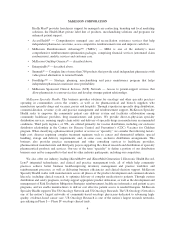McKesson 2015 Annual Report Download - page 21
Download and view the complete annual report
Please find page 21 of the 2015 McKesson annual report below. You can navigate through the pages in the report by either clicking on the pages listed below, or by using the keyword search tool below to find specific information within the annual report.McKESSON CORPORATION
Healthcare Reform: The Affordable Care Act significantly expanded health insurance coverage to uninsured
Americans and changed the way healthcare is financed by both governmental and private payers. While certain
provisions of the Affordable Care Act took effect immediately, others have delayed effective dates. We do not
currently anticipate that the Affordable Care Act or any resulting federal and state healthcare reforms will have a
material impact on our financial position and results of operations. However, given the scope of the changes
made and under consideration, as well as the uncertainties associated with implementation of healthcare reforms,
we cannot predict their full effect on the Company at this time.
Interoperability and Meaningful Use Requirement: There is increasing demand among customers, industry
groups and government authorities that healthcare software and systems provided by various vendors be
compatible with each other. In 2013, in order to address this demand for interoperability we and a number of
other healthcare IT companies co-founded the CommonWell Health Alliance with the aim of developing a
standard for data sharing among doctors, hospitals, clinics and pharmacies. Certain federal and state agencies
also are developing standards that could become mandatory for software and systems purchased by these
agencies, or used by our customers. With respect to legislation addressing interoperability, MACRA promotes
and defines interoperability, requires metrics to measure interoperability, and requires vendors and providers to
attest that they are not blocking data. Regarding meaningful use requirements, the HITECH Act requires
meaningful use of “certified” healthcare information technology products by healthcare providers in order to
receive stimulus funds from the federal government.
Although several of our healthcare information technology products have received certification, rules
regarding meaningful use may be changed or supplemented in the future. As a result of interoperability and
meaningful requirements, we may incur increased development costs and delays in receiving certification for our
products, and changing or supplementing rules also may lengthen our sales and implementation cycle. We also
may incur costs in periods prior to the corresponding recognition of revenue. To the extent these requirements
subsequently are changed or supplemented, or we are delayed in receiving certification for our products,
customers may postpone or cancel their decisions to purchase or implement these products.
FDA Regulation of Medical Software: The FDA has increasingly focused on the regulation of medical
software and health information technology products as medical devices under the federal Food, Drug and
Cosmetic Act. For example, in 2011 the FDA issued a rule on medical device data systems that regulates certain
software systems that electronically store, transfer or display data originating from medical devices as Class 1
medical devices (i.e., those devices deemed by the FDA to be low risk and subject to the least regulatory
controls) themselves. However, in February 2015, the FDA issued guidance to inform manufacturers and
distributors of medical device data systems that it did not intend to enforce compliance with regulatory controls
that apply to medical device data systems, medical image storage devices, and medical image communication
devices. If the FDA chooses to regulate more of our products as medical devices, or subsequently changes or
reverses its guidance regarding not enforcing regulatory controls for certain medical device products, it can
impose extensive requirements upon us. If we fail to comply with the applicable requirements, the FDA could
respond by imposing fines, injunctions or civil penalties, requiring recalls or product corrections, suspending
production, refusing to grant pre-market clearance of products, withdrawing clearances and initiating criminal
prosecution. Any additional FDA regulations governing health information technology products, once issued,
may increase the cost and time to market of new or existing products or may prevent us from marketing our
products.
Standards for Submission of Healthcare Claims: HHS previously adopted two rules that impact healthcare
claims submitted for reimbursement. The first rule modifies the standards for electronic healthcare transactions
(e.g., eligibility, claims submission and payment and electronic remittance) from Version 4010/4010A to Version
5010. The second rule updated and expanded the standard medical code sets for diagnosis and procedure coding
from International Classification of Diseases, Ninth Revision (“ICD-9”) to International Classification of
16
























